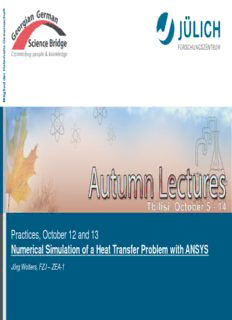
Numerical Simulation of a Heat Transfer Problem with ANSYS PDF
Preview Numerical Simulation of a Heat Transfer Problem with ANSYS
tf a h c s n ie m e G - z tlo h m le H r e d d e ilg tiM Practices, October 12 and 13 Numerical Simulation of a Heat Transfer Problem with ANSYS Jörg Wolters, FZJ – ZEA-1 Numerical Simulations of a heat transfer problem with ANSYS Contents 1. day Introduction to FEM (finite element analysis) Exercise: Cooling of electronic components a) building the geometry b) defining material properties c) simplified thermal simulation d) more precise thermal simulation with fluid elements 2. day Introduction to CFD (computational fluid dynamics) Exercise: Cooling of electronic components e) CFD simulation GeorgianGerman Science Bridge –AutumnLectures 2015.10.12.-13. J. Wolters –ZEA-1 Seite 2von 99 Introduction Finite Element Method (FEM) Public known from e.g. crash simulations for automobile industry Source: Institute for technical and numerical mechanics, University of Stuttgart GeorgianGerman Science Bridge –AutumnLectures 2015.10.12.-13. J. Wolters –ZEA-1 Seite 3von 99 Introduction Finite Element Method (FEM) – how does it work? The Finite Element Method (FEM) is a numerical method for solving problems (differential equations) of engineering and mathematical physics. Useful for problems with complex geometries, loadings, and material properties, for which analytical solutions are not available any more. Applicability: structural/stress analyses, heat transfer, electromagnetic fields, crash , fluid dynamics, fracture mechanics, acoustics … The whole domain is divided into small elements for which the field variables (e.g. displacements for mechanical problems) are interpolated from values at the corners (nodes) by approximating functions. The values of the field variable at the element nodes become the unknown of the problem, from which all other values can be derived (e.g. strains and stresses for structural analyses). derivation approximating nodaldisplacements elementdisplacements strains functions material law Stresses (andforces) Recombining all sets of element equations into a global system of equations, the problem can be solved for the whole domain. Important: The solution of a finite element analysis is not exact but only an approximation that strongly depends on the discretization and the approximating functions. GeorgianGerman Science Bridge –AutumnLectures 2015.10.12.-13. J. Wolters –ZEA-1 Seite 4von 99 Introduction Finite Element Method (FEM) – what are the Benefits? identification of faulty designs and weak spots in the early development phase enhanced product quality analysis of complex systems possible shortening of minimizing costly physical testing* development phases results are available everywhere in the system reduction of development costs fast and easy design optimization in terms of material stressing, weight, stiffness … assessment of lifetime *nevertheless, in most cases experiments are also indispensable in prototype development and only the combination of simulations and experiments will lead to optimal results GeorgianGerman Science Bridge –AutumnLectures 2015.10.12.-13. J. Wolters –ZEA-1 Seite 5von 99 Exercise: Cooling of electronic components Exercise details Geometry cooling pipe electronic components on carbon fiber laminate structure connected to carbon foam GeorgianGerman Science Bridge –AutumnLectures 2015.10.12.-13. J. Wolters –ZEA-1 Seite 6von 99 Exercise: Cooling of electronic components Exercise details Geometry 11 2 5 electronic components 3 (ceramics) 5 . 9 0 carbon fiber laminate carbon foam 3 cooling pipe 2 (steel) .0 1 . 0 GeorgianGerman Science Bridge –AutumnLectures 2015.10.12.-13. J. Wolters –ZEA-1 Seite 7von 99 Exercise: Cooling of electronic components Exercise details Boundary Conditions He mass flow rate: 0.5 g/s pressure: 10 bar inlet temperature: 20°C density: 1.634 kg/m³ Inlet velocity: ~120 m/s specific heat capacity: 5200 J/(kg K) Reynolds number: ~17700 (turbulent) conductivity: 0.15 W/(m K) viscosity: 2e-5 N·s/m² heat transfer coefficient: ~ 4000 W/(m K) Thermal conductivity of materials: Electronics carbon foam: 70 W/(m K) heat generation:1.5 W per block ceramics: 4.5 W/(m K) total heat: 24·1.5 W = 36 W steel: 15 W/(m K) carbon fiber laminate: 10 W/(m K) (in plane) 0.5 W/(M K) (vertical) GeorgianGerman Science Bridge –AutumnLectures 2015.10.12.-13. J. Wolters –ZEA-1 Seite 8von 99 Exercise: Cooling of electronic components set up the simulation project Start WB16.2 from desktop 2 Drag and Drop with LMB (left mouse button) ‘Steady-State Thermal’ to Project Schematic preprocessing solution Post-processing Main Menu => File => Save As… (choose directory and project name) GeorgianGerman Science Bridge –AutumnLectures 2015.10.12.-13. J. Wolters –ZEA-1 Seite 9von 99 Exercise: Cooling of electronic components part a): building the geometry Double-Click (LMB) on Geometry Toolbars Main Menu Tree Outline Sketching / Modeling mode Details View Graphics GeorgianGerman Science Bridge –AutumnLectures 2015.10.12.-13. J. Wolters –ZEA-1 Seite 10von 99
Description: